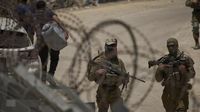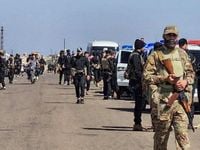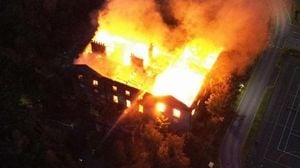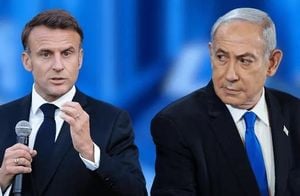Violence has surged once again in Syria’s southern province of Sweida, a region predominantly inhabited by the Druze community, despite a recently brokered ceasefire aimed at halting the bloodshed. The unrest, which has drawn international attention and intervention, underscores the fragile state of Syria’s post-war transition and the complex sectarian tensions that continue to plague the country.
Clashes reignited early on July 16, 2025, between Syrian government forces and local Druze militias just hours after a ceasefire was announced. According to Sweida24, a local news outlet, the city and neighboring villages were subjected to heavy artillery and mortar fire. Syria’s Defense Ministry, through the state news agency SANA, blamed “outlaw groups” in Sweida for breaching the truce. The ministry stated that military forces continued to respond to the source of fire while adhering to rules of engagement designed to protect residents and facilitate the safe return of displaced persons.
The violence in Sweida is rooted in deep-seated sectarian strife, primarily between Druze militias and Sunni Bedouin tribes. The conflict escalated over the weekend of July 12-13, 2025, when violent clashes erupted, resulting in hundreds of deaths, including civilians. Monitoring groups report that Syrian government forces’ involvement further inflamed tensions, with destruction reported in multiple villages. The sectarian nature of the conflict has exacerbated fears of broader instability in the region.
Amid the escalating violence, Israel launched a series of airstrikes targeting Syrian military installations in Damascus and southern Syria, including convoys heading to Sweida. On July 15, 2025, Israeli fighter jets struck the Syrian Defence Ministry and areas near the presidential palace, killing at least three people and injuring over 30, according to Syrian state media. Israel justified the strikes as necessary to protect the Druze minority and to counter Syrian troop movements perceived as threatening the Druze community.
Israeli Defense Minister Israel Katz warned that the military would continue to strike Syrian forces until they withdrew and cautioned that the response would escalate if the message was not heeded. Katz also urged the Syrian government to “leave Druze alone,” reflecting Israel’s positioning of itself as a protector of the Druze minority, which is also a significant community within Israel, often serving in its armed forces.
The United States played a crucial diplomatic role in brokering a ceasefire agreement on July 18, 2025. Secretary of State Marco Rubio confirmed that the U.S. had engaged with multiple actors in the region and secured specific steps to end the conflict. The ceasefire, supported by Turkey, Jordan, and other neighboring countries, aimed to halt the hostilities between the Syrian government and Druze factions. Under the terms of the agreement, Syrian forces began a partial withdrawal from Sweida, though some military checkpoints reportedly remain.
Despite the ceasefire, fighting resumed in parts of Sweida, with renewed clashes reported on July 18. The Syrian presidency announced the deployment of specialized forces to restore calm, emphasizing political and security measures to prevent the return of chaos. U.S. Ambassador to Turkey, Tom Barrack, called on Druze, Bedouin, and Sunni groups to lay down their weapons and work together to build a united Syrian identity.
However, divisions persist within the Druze leadership. Some local religious leaders, including Sheikh Yousef Jarbou, are monitoring the ceasefire, but prominent clerics such as Sheikh Hikmat Al-Hijri have rejected the agreement. Al-Hijri accused government authorities of breaking promises and continuing indiscriminate shelling of civilians, claiming that the Druze community is “being subjected to a total war of annihilation.” This rhetoric highlights the ongoing mistrust and fragmentation within the Druze community and the broader Syrian society.
The Syrian Observatory for Human Rights, a UK-based monitoring group, reported that nearly 600 fighters and civilians had been killed over four days of clashes, with at least 86 civilians executed in the field, mostly Druze Syrians killed by government forces and their allies. The violence has also sparked revenge attacks by Druze militiamen against Sunni Bedouin communities, leading to displacement and renewed insecurity.
The humanitarian situation is dire. Raed al-Saleh, Syria’s Minister of Disaster Management and Emergency Response, stated that hundreds of families had been evacuated from Sweida amid the violence, with over 570 wounded receiving treatment and 87 bodies recovered. The United Nations Human Rights Office reported credible evidence of widespread rights violations, including summary executions, kidnappings, destruction, and looting of homes by all factions involved, including government forces, Druze, and Bedouin fighters. UN rights chief Volker Turk condemned the bloodshed and called for the protection of all civilians in line with international law.
The UN Refugee Agency also expressed grave concern over the impact of hostilities on aid operations, noting that their capacity to deliver assistance in Sweida is severely limited due to ongoing insecurity. Humanitarian access remains a critical challenge as fighting continues sporadically despite diplomatic efforts.
International diplomatic efforts have been intense. Turkey’s Foreign Minister Hakan Fidan and intelligence chief İbrahim Kalin engaged in talks with U.S. mediators and regional leaders, including Lebanese Druze leader Walid Jumblatt, to de-escalate tensions. The United Nations Security Council is expected to convene an emergency session to address the crisis, underscoring the global stakes involved.
The Druze community, an offshoot of Ismailism with a population of roughly one million worldwide, is concentrated in Syria, Lebanon, and Israel. The Golan Heights, annexed by Israel in 1981 after the 1967 war, is home to a significant Druze population that has close ties to their brethren in Syria. The conflict has prompted thousands of Druze residents in the Israeli-controlled Golan to gather at the border, with some crossing into Syria in attempts to aid their community or visit relatives. Israeli security forces have been working to manage these crossings while reinforcing border fences to prevent uncontrolled movement.
Syrian interim President Ahmad al-Sharaa has emphasized the Druze as an integral part of Syria’s national fabric and vowed to hold accountable those responsible for abuses during the fighting. However, the ongoing sectarian violence and political fragmentation present significant obstacles to national reconciliation.
As Syria navigates its fragile post-war landscape, the violence in Sweida serves as a stark reminder of the challenges ahead. The interplay of local sectarian rivalries, government authority, and regional geopolitical interests creates a volatile mix. With international actors deeply involved and humanitarian needs mounting, the path to lasting peace remains uncertain.
For now, the ceasefire offers a fragile pause in hostilities, but the underlying tensions and grievances risk reigniting violence. The international community’s continued engagement and support for inclusive political solutions will be critical to preventing further bloodshed and fostering stability in this troubled region.





